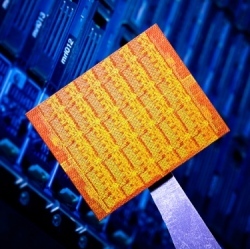
Michigan Technological University scientists led by professor of physics Yoke Khin Yap have created a quantum tunneling device that acts like like an FET transistor and works at room temperature — without using semiconducting materials.
The trick was to use boron nitride nanotubes (BNNTs) with quantum dots made from gold.
When sufficient voltage is applied to the device, it switches from insulator to a conducting state. When the voltage is low or turned off, it reverts to its natural state as an insulator.
There is no leakage current of electrons escaping from the gold dots into the insulating BNNTs, thus keeping the tunneling channel cool. In contrast, silicon is subject to leakage, which wastes energy in electronic devices and generates a lot of heat, limiting miniaturization of transistors.
Yap’s team had figured out in 2010 how to make virtual carpets of BNNTs, which are insulators, and thus highly resistant to electrical charge.
Using lasers, the team then placed quantum dots (QDs) of gold as small as three nanometers across on the tops of the BNNTs, forming QDs-BNNTs. BNNTs are the perfect substrates for these quantum dots due to their small, controllable, and uniform diameters, as well as their insulating nature. BNNTs confine the size of the dots that can be deposited.
In collaboration with scientists at Oak Ridge National Laboratory (ORNL), the team fired up electrodes on both ends of the QDs-BNNTs at room temperature.
Something interesting then happened: electrons jumped very precisely from gold dot to gold dot — a phenomenon known as quantum tunneling.
“Imagine that the nanotubes are a river, with an electrode on each bank. Now imagine some very tiny stepping stones across the river,” said Yap. “The electrons hop between the gold stepping stones.
